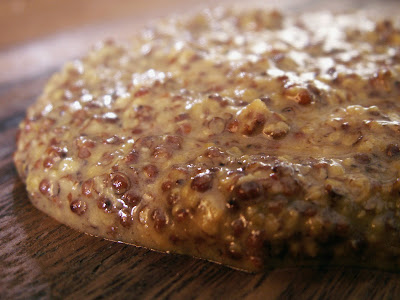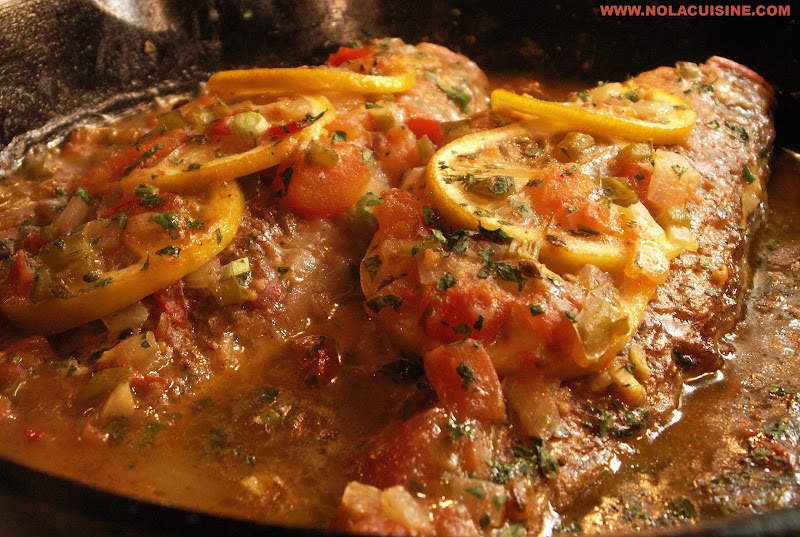 |
| From |
Creole Mustard is essential in the Louisiana pantry, used in many different preparations where Dijon would be used elsewhere. What would Remoulade sauce be without it? In my search for the characteristics that make Creole Mustard Creole, I found the following definition in what is one of my favorite books on Louisiana cooking American Cooking: Creole and Acadian by Peter S. Feibleman:
Pungent prepared mustard made from the spicy brown mustard seeds rather than the more familiar, but somewhat blander, yellow seeds. The seeds are steeped in distilled white vinegar, then coarsely ground and left to marinate for up to 12 hours longer before packing.
That says a lot about the preparation, but not much about the origin which is always of interest to me. I assume German Creoles were behind the earliest preparations but even more interesting to me is this passage from The Picayune’s Creole Cookbook of 1901:
Mustard is grown extensively in Louisiana, especially the large leaved or curled, which has grown to be a distinct Louisiana variety, quite different from the European. The seed is black, and is raised in Louisiana, and the plant is being more extensively cultivated every year. The large leaves are cooked the same as Spinach, or they may be boiled with salt meat and served as Greens.
Our Creole Mustard Seeds are famous, not only in making sauces, but for medicinal purposes.
The namesake as it turns out is more about the variety of Mustard plant than it is preparation. The book also contains a Creole Mustard Recipe calling for a pound of the above mentioned Creole Mustard. In addition, I also came across this page about black mustard seed that states the following:
The spicy component of black mustard seed is called ‘isothiocyanate’ and it is also found in horseradish and wasabi which belong to the same plant family.
My recipe is made with the more commonly found brown mustard seed and has an addition of horseradish which I think is a flavor must for a good Creole Mustard. In addition to the horseradish this recipe has an added punch which comes from a touch of Cayenne, as well as the garlic and crushed red pepper that I use to flavor the vinegar before steeping the seeds. Here is my homemade Creole Mustard Recipe:
 |
| From Nola Cuisine |
Creole Mustard Recipe
1/2 Cup Distilled White Vinegar
1/2 tsp Crushed Red Pepper
2 Cloves Garlic, chopped
1/2 Cup Brown Mustard Seeds, crushed
1 Tbsp Freshly Grated Horseradish
Pinch Cayenne Pepper
Pinch Ground Allspice
1 tsp Kosher Salt
1 tsp Granulated Sugar
1 tsp Steen’s 100% Pure Cane Syrup
4 Tbsp Coleman’s Mustard powder
1 small canning jar with lid, sterilized
Place the vinegar, crushed red pepper, and garlic into a small saucepan, bring to a boil. Turn off the heat and let steep for 15-20 minutes then strain the mixture, discard the solids. Bring back to a boil then add the mustard seeds, turn off the heat and let steep for 30 minutes.
In a small bowl combine the vinegar with the horseradish, cayenne, salt, sugar, cane syrup, and brown mustard seed. Whisk in the mustard powder. Pour into the sterilized jar, put the lid on and process in a water bath for 15 minutes. When cool, tighten the lid, and make sure the jar is sealed. Place in a cool dark place and let mature for at least 3-4 weeks before using. This step will allow the flavors to marry and mellow which will not be able to take place in the refrigerator, although the mustard will need to be refrigerated after opening.
 |
| From Nola Cuisine |
Be sure and check out my ever growing Index of Creole & Cajun Recipes which features links to all of the recipes featured on this site!



